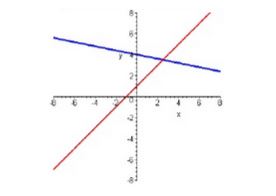Solving Linear Systems
Sometimes, we are interested in solving two linear equations simultaneously for x and y...graphically, this means finding the point of intersection of two lines. There are two methods commonly used in high school when solving a system of equations, so let's review these. The first method is solving by substitution and the second is solving by elimination...either one can be used, and they will of course give you the same results.
Solving by Substitution
Let's start by taking a closer look at solving a system of equations using the substitution method. The method is as follows:
- Solve one of the equations for one of the variables (i.e., isolate the variable);
- Substitute the equation from step 1 into the other equation;
- You should now have an equation in one variable, so solve it; finally,
- Substitute the solution from step 3 into one of the equations to solve for the other variable.
Example: Solve for x and y using the method of substitution.
1) -x + y = 4
2) x + 2y = 5
Solution:
Rearrange equation 1 to solve for y:
y = 4 + x
Substitute the rearranged equation into equation 2:
x + 2(4 + x) = 5
x + 8 + 2x = 5
3x = -3
x = -1
Sub x into equation 1:
-(-1) + y = 4
1 + y = 4
y = 3
Therefore, x = -1 and y =3
Note: In the example above, equation 1 was rearranged to solve for y. However, the same final answer would have been reached regardless of which equation was rearranged and which variable was isolated. In the last step, the solution for x was substituted into equation 1 to solve for y; however, it could have been substituted into equation 2 just as easily.
Solving by Elimination
Now we will take a look at solving a system of equation using the elimination method. The elimination method involves removing one of the variables from the equations through the use of either addition or subtraction. The method can be summarized as follows:
- Multiply all terms of one or both equations by appropriate factors so that both equations will have the same coefficient for one of the variables;
- Add or subtract the two new equations to eliminate one of the variables;
- Solve for the resulting variable; and
- Substitute the solution from step 3 into one of the original equations to solve for the other variable.
Example: Solve for x and y using the method of elimination.
1) -x + y =4
2) x + 2y = 5
Solution:
Add equation 1 to equation 2:
-x + y + x + 2y = 4+5
3y = 9
y = 3
Sub y into equation 1:
-x + (3) = 4
-x = 1
x = -1
Therefore, x = -1 and y = 3.
Note: In the above example, neither of the equations needed to be manipulated in order to have a term eliminated from the equations, since -x + x = 0. Therefore, the two equations were simply added together. In the last step, note that we could also have substituted y = 3 into equation 2 to solve for x.
Example 1 (Substitution):
Example 2 (Elimination):
Example 3 (Elimination):
Setting Up and Solving Linear Systems (Application):
Solving a Linear System business word problem (Application):

